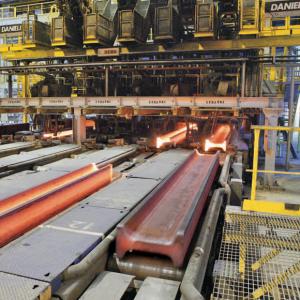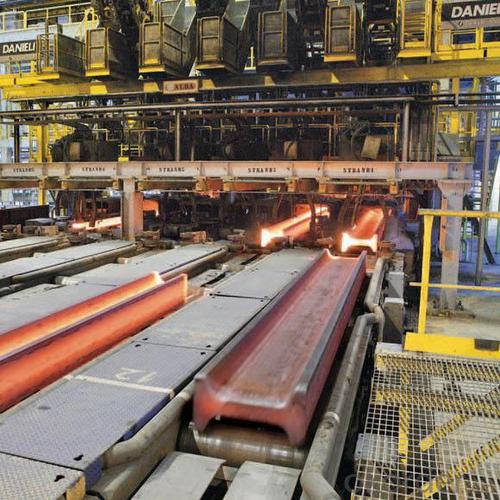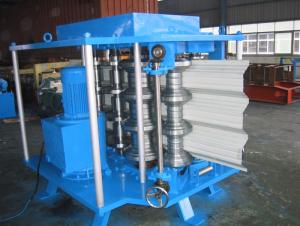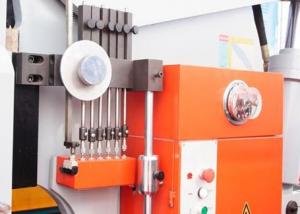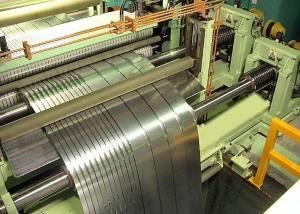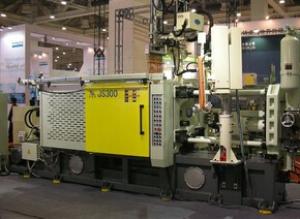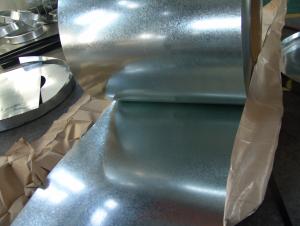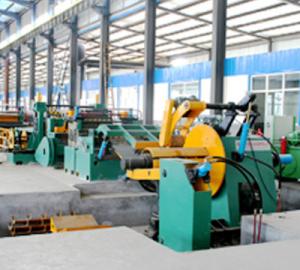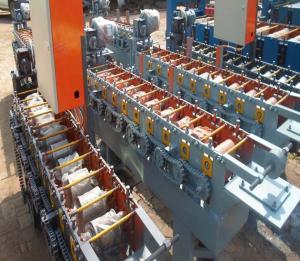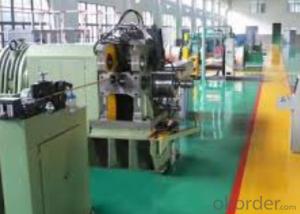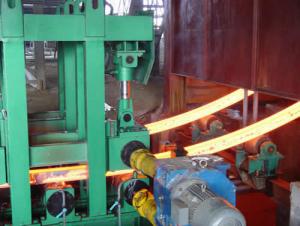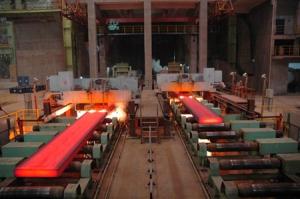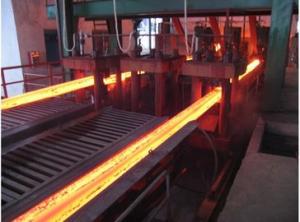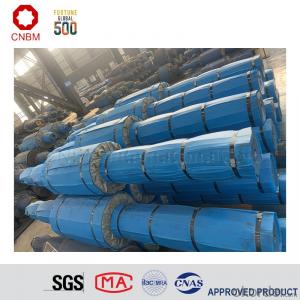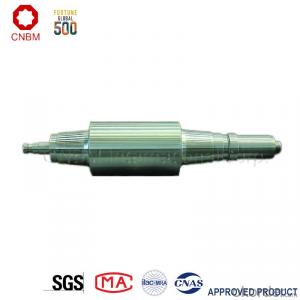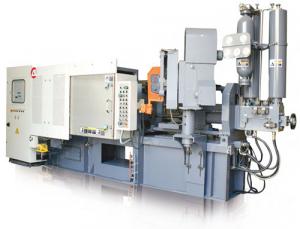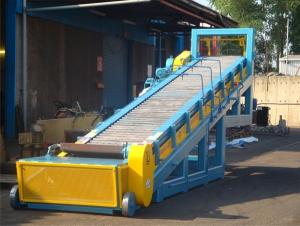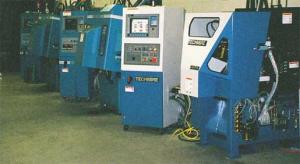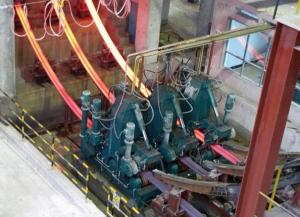Continuous Casting Machine (R4M 3-Strand)
- Loading Port:
- China Main Port
- Payment Terms:
- TT or LC
- Min Order Qty:
- 1 Set set
- Supply Capability:
- 20 Sets Per Year set/month
OKorder Service Pledge
Quality Product, Order Online Tracking, Timely Delivery
OKorder Financial Service
Credit Rating, Credit Services, Credit Purchasing
You Might Also Like
Technology process:
1.Heat the EVA film
2.Cover the heated EVA film on the mould(can be made from wood or aluminum)
3.Spray a coating in a certain baume degree
4.Put on the empty blask
5.Sand-up the flask and vibrate to compaction
Packaging & Delivery
Packaging Details:containers
Delivery Detail:Complete one set of equipment needs for three months
- Q: What is the role of data analytics in metal casting machinery?
- The significance of data analytics in metal casting machinery cannot be overstated when it comes to enhancing efficiency, quality, and overall productivity in the manufacturing process. Data analytics involves the collection, analysis, and interpretation of large data sets to derive valuable insights and make informed decisions. In the realm of metal casting machinery, data analytics can be utilized to monitor and optimize various aspects of the production process. Manufacturers can gather data from sensors and other monitoring devices installed in the machinery to analyze key performance indicators (KPIs) like temperature, pressure, flow rates, and cycle times. Through the application of data analytics, manufacturers can detect patterns and trends in the data, enabling them to identify any abnormalities or deviations from expected performance. This facilitates prompt issue identification and resolution, resulting in decreased machine downtime and improved overall equipment effectiveness (OEE). By implementing predictive analytics models, manufacturers can also anticipate potential failures or maintenance requirements, allowing for proactive measures to prevent costly breakdowns. Additionally, data analytics can aid in optimizing the casting process itself. By analyzing both historical data and real-time information, manufacturers can pinpoint areas for improvement, such as adjusting process parameters or optimizing mold designs. This can lead to higher quality castings, reduced scrap rates, and improved yield. Quality control is another critical aspect where data analytics plays a pivotal role. By collecting and analyzing data from various stages of the casting process, manufacturers can identify potential defects or variations in product quality. This enables them to take immediate corrective actions, minimizing rejects and ensuring consistent quality standards. Furthermore, data analytics empowers manufacturers to gain valuable insights into overall production performance. By analyzing data across multiple machines or production lines, manufacturers can identify bottlenecks, inefficiencies, or opportunities for optimization. This can result in increased throughput, reduced lead times, and improved resource allocation. In conclusion, data analytics in metal casting machinery empowers manufacturers to make data-driven decisions that optimize efficiency, quality, and productivity. By harnessing the power of data, manufacturers can continuously enhance their processes, reduce costs, and remain competitive in the ever-evolving manufacturing industry.
- Q: How does metal casting machinery handle the removal of impurities from the castings?
- Metal casting machinery handles the removal of impurities from castings through various methods such as gating and risering, using filters, and employing techniques like degassing and fluxing. These processes help to separate and eliminate unwanted elements, ensuring the production of high-quality castings with minimal impurities.
- Q: How are alloys prepared and controlled for continuous casting in metal casting machinery?
- Continuous casting in metal casting machinery involves a series of meticulously planned steps to prepare and control alloys. The process follows these general steps: 1. Choosing the Alloy: The initial step is to select the suitable alloy composition for the desired end product. This decision is based on the specific mechanical, physical, and chemical properties required for the application. 2. Melting: Next, the selected alloys are melted in a furnace under controlled conditions to ensure consistency and uniformity. The temperature, atmosphere, and duration of melting are crucial factors in achieving the desired alloy properties. 3. Adding Alloying Elements: In certain cases, alloying elements are introduced during the melting process to enhance specific properties of the alloy. These elements can be added as master alloys or individual elements to attain precise control over the alloy composition. 4. Removing Impurities: To enhance the quality of the alloy, degassing and refining processes are employed. These processes eliminate impurities like oxygen, hydrogen, and non-metallic particles, which can have adverse effects on the casting quality. 5. Utilizing Continuous Casting: Once the molten alloy is ready, it is transferred to the continuous casting machine. This machine consists of a continuously cooled mold that solidifies the molten metal into a continuous strand. The casting speed and cooling rate are carefully regulated to ensure uniformity and prevent defects. 6. Controlling Temperature: Throughout the continuous casting process, the temperature of the molten alloy is closely monitored and controlled. This is essential to maintain the desired casting speed and prevent premature solidification, which can result in defects. 7. Managing Solidification: As the alloy solidifies within the continuous casting machine, various techniques are employed to control the solidification process. These techniques may include water sprays or electromagnetic devices to regulate the cooling rate, ensuring a uniform structure and minimizing defects. 8. Ensuring Quality: Various quality control measures are implemented during continuous casting to detect and eliminate defects. These measures may involve online monitoring systems, such as thermal imaging or ultrasonic testing, to identify cracks, voids, or other imperfections. In summary, the preparation and control of alloys for continuous casting in metal casting machinery require careful attention to alloy selection, melting, refining, continuous casting parameters, and quality control measures. By optimizing these steps, manufacturers can produce high-quality castings with the desired properties and specifications.
- Q: Can metal casting machinery be used for the production of valve components?
- Yes, metal casting machinery can be used for the production of valve components. Metal casting is a manufacturing process where molten metal is poured into a mold to create a desired shape. This process is commonly used in the production of various industrial components, including valve components. Valve components, such as valve bodies, discs, and stems, can be efficiently manufactured using metal casting machinery. The process allows for the creation of complex shapes and intricate designs, ensuring that the valve components meet the required specifications and performance standards. Metal casting machinery offers a wide range of options in terms of materials that can be used for valve component production. Different types of metals, such as iron, steel, aluminum, and brass, can be melted and poured into the molds to create valve components with specific properties, such as strength, corrosion resistance, and heat resistance. Furthermore, metal casting machinery enables the production of valve components in large quantities, making it suitable for high-volume manufacturing. The process is cost-effective, as it eliminates the need for extensive machining or fabrication, reducing labor and material costs. In conclusion, metal casting machinery can definitely be used for the production of valve components. It provides a reliable and efficient method for manufacturing valve components, offering flexibility in terms of shapes, materials, and quantities produced.
- Q: How do you assess the demand and market potential for metal casting equipment?
- To assess the demand and market potential for metal casting equipment, I would conduct market research and analysis. This would involve studying the current market trends, analyzing the demand for metal casting equipment in various industries, and identifying potential growth opportunities. Additionally, I would assess the competitive landscape, considering factors such as the number of existing suppliers, their market share, and their pricing strategies. I would also gather feedback from potential customers and industry experts to understand their needs and preferences. By combining these insights, I would be able to evaluate the demand and market potential for metal casting equipment and make informed business decisions.
- Q: Can metal casting machinery be used for producing hollow castings?
- Yes, metal casting machinery can be used to produce hollow castings. This is achieved by using a hollow core or pattern in the mold, which allows space for the molten metal to flow and solidify around it, creating a hollow cavity in the final casting.
- Q: What are the different types of packaging and shipping methods used for castings produced by metal casting machinery?
- There are several types of packaging and shipping methods used for castings produced by metal casting machinery. Some common packaging methods include wooden crates, corrugated boxes, and pallets. These provide protection and ensure safe transportation of the castings. As for shipping methods, options such as air freight, sea freight, and land transportation are commonly used depending on the distance and urgency of delivery. Each method has its own advantages and considerations, such as cost, speed, and handling requirements. Ultimately, the choice of packaging and shipping method depends on the specific requirements and preferences of the customer and the casting manufacturer.
- Q: How is the casting inspected for surface defects in metal casting machinery?
- The casting is inspected for surface defects in metal casting machinery through various methods such as visual inspection, dye penetrant testing, magnetic particle inspection, and ultrasonic testing. These techniques help identify any cracks, porosity, shrinkage, or other surface defects that may affect the quality and integrity of the casting.
- Q: How are costs calculated in metal casting machinery operations?
- Costs in metal casting machinery operations are calculated by considering various factors. These factors include the initial investment in the machinery, its maintenance and repair costs, the cost of raw materials used in the casting process, labor costs, energy consumption, and overhead expenses. The initial investment in the machinery is a significant cost that needs to be considered. This includes the cost of purchasing or leasing the machinery, as well as any installation or setup expenses. Additionally, ongoing maintenance and repair costs are calculated to ensure the machinery remains in good working condition. These costs may include regular inspections, replacement of worn-out parts, and repairs due to breakdowns or malfunctions. The cost of raw materials used in metal casting, such as metals or alloys, is another crucial factor. This includes the purchase price of the raw materials, as well as any transportation or storage costs associated with them. The quantity of raw materials required for each casting operation is also considered in the calculation. Labor costs are an essential component of the overall cost of metal casting machinery operations. This includes wages or salaries for operators, technicians, and other personnel involved in the casting process. The number of hours worked and the skill level of the workers are taken into account to determine labor costs. Energy consumption is another factor that affects costs in metal casting machinery operations. The amount of electricity or other energy sources used by the machinery is calculated based on the duration and intensity of its operation. The cost per unit of energy consumed is then multiplied by the total energy consumption to determine the energy cost. Lastly, overhead expenses, such as rent, insurance, taxes, and administrative costs, are factored into the overall cost calculation. These costs are typically allocated to each casting operation based on a predetermined allocation method, such as the machine usage time or the number of castings produced. In summary, costs in metal casting machinery operations are calculated by considering the initial investment in the machinery, maintenance and repair costs, the cost of raw materials, labor costs, energy consumption, and overhead expenses. By accurately calculating these costs, manufacturers can determine the profitability of their casting operations and make informed decisions regarding pricing, production volume, and process improvements.
- Q: What are the cost considerations when using metal casting machinery?
- When utilizing metal casting machinery, there are various factors to consider in terms of cost. To begin with, the initial investment in the machinery itself can be substantial. The price of metal casting machinery can vary depending on its size, type, and capabilities. Therefore, it is crucial to examine the available budget and financial resources before deciding on a specific machinery purchase. Apart from the upfront cost, there are ongoing expenses to take into account. This includes the cost of raw materials, such as metal alloys, which can fluctuate in price based on their type and quality. Additionally, the cost of consumables, like refractory materials and coatings, should be considered. Operational costs are another important consideration. Metal casting machinery requires electricity to function, so the energy consumption and associated utility costs must be factored in. Furthermore, regular maintenance and repair costs should be taken into consideration to ensure optimal performance and durability. Labor costs are an additional factor to consider. Skilled operators or technicians are often necessary to efficiently and effectively operate the machinery. The wages and benefits of these personnel should be included in the overall cost analysis. Furthermore, it is essential to assess the production output and efficiency of the metal casting machinery. Higher-quality machinery may result in increased production rates and reduced labor costs over time. However, it is crucial to strike a balance between the potential benefits of more advanced machinery and the associated costs. Lastly, evaluating the potential return on investment (ROI) is crucial when considering metal casting machinery. Factors such as increased production capacity, improved product quality, reduced scrap rates, and faster turnaround times should be taken into account when assessing the financial impact of the machinery on overall business operations. In conclusion, cost considerations when using metal casting machinery involve a comprehensive assessment of initial investment, ongoing expenses, operational costs, labor costs, production output, and potential ROI. Analyzing these factors properly will help determine the economic viability and long-term financial impact of utilizing metal casting machinery.
Our professions include metallurgical technology, equipment and automation. We can provide the best solutions to the production process, design & manufacture of equipment and electrical automation regarding various industries in domestic and foreign districts with exquisite technology and fine quality service. We can provide all-around services to customers from development & design to the provision, installation and running of products.Strong technical strength, advanced equipment manufacturing technology, fine quality professional talents, and perfect service systems all bring about reliability, relaxation, convenience and delight to the cooperation with customers from beginning to end.
1. Manufacturer Overview
| Location | Jiangsu,China (Mainland) |
| Year Established | 2000 |
| Annual Output Value | |
| Main Markets | South America Eastern Europe Southeast Asia Africa Mid East South Asia Domestic Market |
| Company Certifications |
2. Manufacturer Certificates
| a) Certification Name | |
| Range | |
| Reference | |
| Validity Period |
3. Manufacturer Capability
| a) Trade Capacity | |
| Nearest Port | SHANGHAI |
| Export Percentage | 21% - 30% |
| No.of Employees in Trade Department | 3-5 People |
| Language Spoken: | English, Chinese |
| b) Factory Information | |
| Factory Size: | |
| No. of Production Lines | |
| Contract Manufacturing | |
| Product Price Range | |
Send your message to us
Continuous Casting Machine (R4M 3-Strand)
- Loading Port:
- China Main Port
- Payment Terms:
- TT or LC
- Min Order Qty:
- 1 Set set
- Supply Capability:
- 20 Sets Per Year set/month
OKorder Service Pledge
Quality Product, Order Online Tracking, Timely Delivery
OKorder Financial Service
Credit Rating, Credit Services, Credit Purchasing
Similar products
Hot products
Hot Searches
